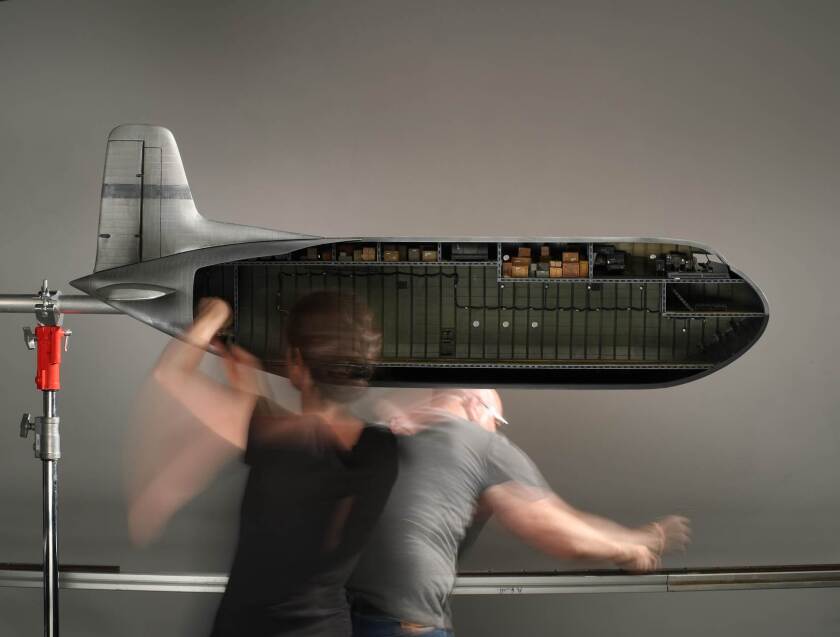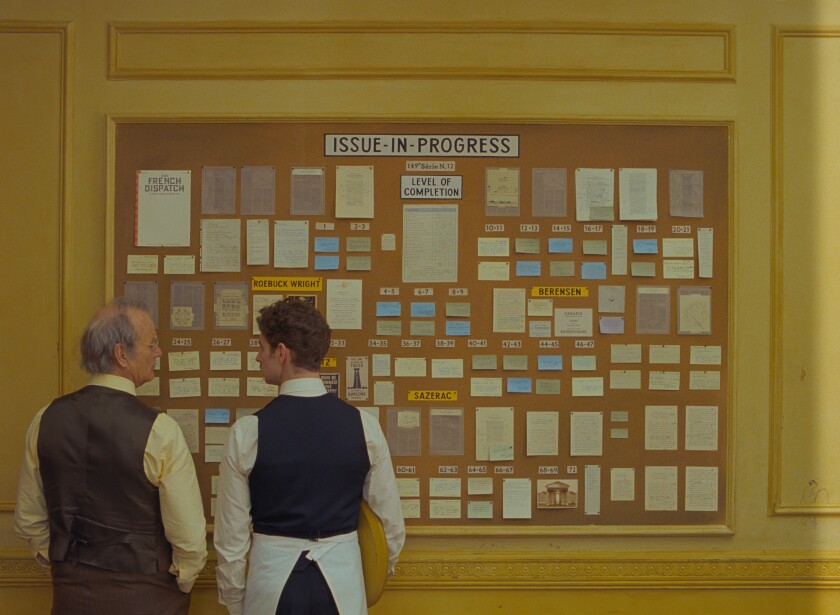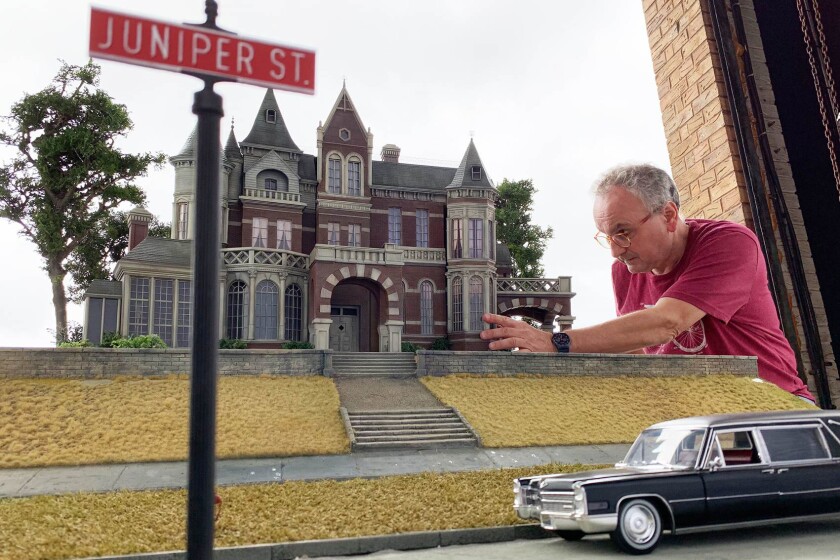It may come as no surprise that “every inch” of the production design in a Wes Anderson film is examined and discussed. The bespoke worlds behind his movies are beautifully detailed with rich artistry that immerses audiences in the characters, relationships and stories that appear onscreen.
Adam Stockhausen is no stranger to collaborating with the auteur, having crafted several films including winning an Academy Award for “The Grand Budapest Hotel” with set decorator Anna Pinnock. In “The French Dispatch,” the production designer was tasked with curating the visual style of four dueling magazine articles written in France and which grace the final pages of the French Dispatch, an insert of the Liberty, Kansas Evening Sun.
“Reading the script, you could tell how ambitious it was and how many different locations and sets we would be visiting. The descriptions were all there on the page so the details blow your hair back a bit,” Stockhausen tells The Envelope over the phone while shooting “Asteroid City,” the director’s next project.
The film features an ensemble cast that includes Bill Murray, Benicio del Toro, Frances McDormand, Tilda Swinton, Owen Wilson, Jeffrey Wright and Timothée Chalamet. Each of the four chapters presents a distinct palette combining color, mood and contrast to bring them to life. “The Concrete Masterpiece” uncovers an imprisoned artist stylized in a milky black-and-white backdrop; “Revisions to a Manifesto” follows a student uprising, mixing muted pastels and monochromatic tones; “The Private Dining Room of the Police Commissioner” is a saucy crime thriller that wafts of French New Wave filmmaking; and “The Cycling Reporter” vividly jaunts through the city on a tour of its past and present.

Tilda Swinton’s airplane scene uses a portion of the main cabin as a practical set while the rest is miniature.
(Searchlight Pictures)

A miniature airplane is prepared for “The French Dispatch.”
(Searchlight Pictures)
Design cues were inspired from reference material including the 1956 short film “The Red Balloon” from Albert Lamorisse, which brings color to postwar Paris, Orson Welles’ “The Trial” and works from Jean-Luc Godard, Jacques Tati and Jean Renoir, among a vast collection of photos of France dating to the mid-1800s to aid in set decoration, headed by Rena DeAngelo.
Production settled on Angoulême in the southwest region of France to stand in for the film’s fictional town of Ennui-sur-Blasé, a decision that allowed the team to convert a former felt factory into a soundstage and stitch together a number of locations for its visual makeup. “When we started thinking about this town and what it looks like, you think about the hundreds of details — the twists in the roads, the arches, the stairways, the gutters — it’s the hundreds of small things that start to add up to the big picture of what the place is,” says Stockhausen. “From there, you can figure out how the individual stories inhabit that place.”
It took roughly 130 different sets to pull off the feat, all of which were painstakingly designed to match the exactness of the frame as scenes were shot with different aspect ratios. Using an animatic process, shooting storyboards to mimic the film to come, allowed them to map each story to its practical counterpart. For the prison chapter (with Del Toro), Stockhausen created the set in the shell of an empty building. The main entrance housed the cell blocks, the upper portion was used for the art show where Adrien Brody’s character and his wealthy cronies come to bid on the prisoner’s work. The basement combined the laundry room and a separate arrival area while individual cells were built offsite and matched for continuity.

Elisabeth Moss, from left, Owen Wilson, Tilda Swinton, Fisher Stevens and Griffin Dunne sit in the editorial offices in a scene from the film “The French Dispatch.”
(Searchlight Pictures)

The French Dispatch editorial office was a mix of designs to show a building that has had many uses over the decades. One way “there’s this kind of peg board partition, then you turn the other way and it is floor-to-ceiling file boxes,” says production designer Adam Stockhausen.
(Searchlight Pictures)
Miniatures, another signature style of Anderson’s, were sprinkled throughout the tapestry. Simon Weisse, a prop maker who teamed with Stockhausen on “The Grand Budapest Hotel” and “Isle of Dogs,” designs them from sketches in which the tiny lifelike props are combined with full-sized sets. The most notable of these are the top of the French Dispatch building as a miniature with full-scale shops down below and Swinton’s airplane scene where a portion of the main cabin was practical and the rest miniature.
While the film doesn’t take place during a specific era beyond postwar Europe, sets were decorated by DeAngelo from pieces found in flea markets and estate sales from Paris to Angoulême that fit the framework of the story. “We mixed a bunch of things together. Some were from the 1920s, ‘30s or even ‘60s, while portions of the Jeffrey Wright story might be looking back from the 1970s,” notes Stockhausen.
To bring together the newsroom, in particular the office where Murray serves as its chief editor, color proved to be the motivating factor as a muted yellow covers the walls of the hodgepodge space, a hue that’s plotted throughout different storefronts, Citroën vehicles and costumes, subliminally tying them together.
“We wanted the building to feel as if it had different uses and is now being inhabited by the French Dispatch. When you look one way, you see the grand architecture of Bill’s desk and then you look in another direction there’s this kind of peg board partition, then you turn the other way and it is floor-to-ceiling file boxes,” says Stockhausen. “We let the space breathe and grow through the project and that’s where a lot of the energy comes in. We even had Javi Aznarez, who did the illustration for the cover of the French Dispatch, come in and draw on the final set walls, which really gave it light.”

Miniatures are a common Wes Anderson production element, with the tiny lifelike props being combined with full-sized sets.
(Searchlight Pictures)

Miniatures are a common filming device in Wes Anderson movies.
(Searchlight Pictures)
For all the latest Entertainment News Click Here
For the latest news and updates, follow us on Google News.
